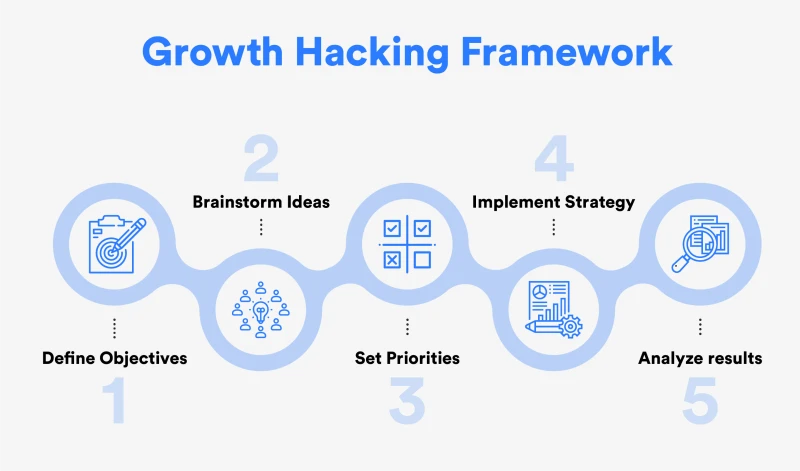
The travel industry is constantly evolving and the competition is always high. To stay ahead of the game, travel businesses need to constantly adapt and implement growth hacking strategies to ensure continuous growth. Here are 40 top growth hacking strategies for travel businesses to consider:
Understanding Growth Hacking in the Travel Industry
Growth hacking is a data-driven approach to marketing that focuses on building a loyal customer base and increasing revenue through the use of creative and innovative marketing techniques. In the travel industry, growth hacking involves using a combination of traditional and online marketing tactics to identify potential customers, engage with them, and convert them into loyal customers.
What is Growth Hacking?
Growth hacking is a marketing strategy that is focused on achieving growth quickly and efficiently. It involves experimenting with different marketing strategies and tactics to identify the most effective way to drive growth. Growth hackers use data to analyze their target audience and optimize their marketing campaigns for maximum results.
For example, a travel business could use growth hacking to identify the most popular destinations among their target audience and create targeted marketing campaigns to promote those destinations. They could also use data to identify the most effective social media platforms for engaging with their audience and use those platforms to promote their business and build brand awareness.
Another growth hacking strategy that travel businesses could use is to offer incentives to customers who refer their friends and family to the business. This could be in the form of discounts, freebies or other rewards that encourage customers to spread the word about the business.
Why is Growth Hacking Important for Travel Businesses?
In the travel industry, competition is fierce and travelers have many options to choose from. To stand out from the crowd, travel businesses need to implement creative and effective marketing strategies that drive growth and increase revenue. Growth hacking is a great way to achieve this, as it allows businesses to quickly test and scale marketing campaigns, while minimizing costs.
One of the key benefits of growth hacking is that it allows businesses to identify the most effective marketing channels for their target audience. By experimenting with different marketing tactics and analyzing the results, businesses can determine which channels are most effective and focus their efforts on those channels to drive growth.
Growth hacking can also help travel businesses to build a loyal customer base. By using data to understand their customers’ needs and preferences, businesses can create personalized marketing campaigns that resonate with their audience and build trust and loyalty over time.
Overall, growth hacking is an essential strategy for travel businesses that want to stay competitive and grow their customer base. By using data to drive their marketing efforts and experimenting with new tactics and strategies, businesses can achieve growth quickly and efficiently, while building a loyal customer base that will help to sustain their business over the long term.
Building a Strong Online Presence
Having a strong online presence is essential for any travel business that wants to succeed in today’s digital world. With so many options available to travelers, it’s important to stand out from the crowd and make a lasting impression. Here are some strategies for building a strong online presence:
Optimizing Your Website for Conversions
A website that is optimized for conversions can help travel businesses to attract new customers and increase revenue. To optimize your website for conversions, you need to make it easy for visitors to find what they’re looking for and take action. This can include using clear calls to action, improving website speed, and optimizing the user experience.
One way to improve the user experience is to make your website mobile-friendly. With more and more people using their smartphones to browse the web, it’s important to ensure that your website is easy to navigate on a smaller screen. You can also add features like chatbots to your website to help visitors find the information they need quickly and easily.
Another important aspect of website optimization is search engine optimization (SEO). By optimizing your website for search engines, you can improve your visibility in search results and attract more organic traffic. This can include optimizing your website’s content, using relevant keywords, and building high-quality backlinks.
Leveraging Social Media Platforms

Social media platforms like Facebook, Instagram, and Twitter are great tools for building brand awareness and engaging with potential customers. To leverage social media platforms effectively, travel businesses should create engaging and shareable content, use targeted advertising to reach the right audience, and track their results to optimize their campaigns.
One way to create engaging content is to share user-generated content (UGC). UGC is content created by your customers, such as photos and reviews, that can be shared on your social media channels. This can help to build trust and credibility with your audience, as well as encourage them to engage with your brand.
Another way to leverage social media platforms is to use influencer marketing. Influencer marketing involves partnering with social media influencers and bloggers to promote your brand to their followers. By working with influencers that align with your brand values, you can reach new audiences and generate buzz around your brand.
Utilizing Influencer Marketing
Influencer marketing can be a powerful tool for travel businesses that want to reach a wider audience. By partnering with influential travel bloggers and social media influencers, businesses can reach new audiences and generate buzz around their brand. To successfully utilize influencer marketing, businesses should identify influencers that align with their brand values and work with them to create engaging content that resonates with their audience.
One way to identify influencers is to use influencer marketing platforms like AspireIQ and Upfluence. These platforms allow you to search for influencers based on their niche, audience size, and engagement rate. You can also use social media monitoring tools like Hootsuite and Mention to track mentions of your brand and identify potential influencers.
When working with influencers, it’s important to establish clear goals and expectations. This can include the type of content they will create, the channels they will promote it on, and the timeline for delivery. You should also provide influencers with any necessary guidelines and ensure that they disclose their partnership with your brand.
By implementing these strategies, travel businesses can build a strong online presence and attract new customers. Whether you’re optimizing your website for conversions, leveraging social media platforms, or utilizing influencer marketing, it’s important to stay up-to-date with the latest trends and best practices in digital marketing.
Creating Engaging Content
Creating engaging content is key to attracting and retaining customers in the travel industry. Here are some strategies for creating engaging content:
Crafting Compelling Blog Posts
Blogging is a great way to create valuable content that attracts and retains customers. To craft compelling blog posts, travel businesses should research their audience to understand their interests and pain points, write in a conversational tone, and use engaging visuals to accompany their content.
Producing Eye-Catching Visuals
Visual content like photos and videos can be a powerful tool for travel businesses that want to showcase their offerings and attract new customers. To produce eye-catching visuals, businesses should invest in high-quality equipment and editing software, and consider partnering with professional photographers or videographers.
Developing Shareable Infographics
Infographics are a great way to present complex information in an engaging and shareable format. To develop shareable infographics, travel businesses should focus on creating visually appealing designs, using data that is interesting and relevant to their audience, and presenting information in a clear and concise manner.
Implementing SEO Strategies
SEO (search engine optimization) is a crucial aspect of marketing for any business with an online presence. Here are some strategies for implementing SEO:

Conducting Keyword Research
Keyword research is a vital step in optimizing a website for search engines. By identifying relevant keywords that people are searching for, businesses can optimize their website content to rank higher in search engine results pages.
Optimizing On-Page SEO Elements
On-page SEO elements, such as meta descriptions, header tags, and internal linking, can have a significant impact on how search engines crawl and index a website. To optimize on-page SEO elements, businesses should ensure that their content is keyword-rich, easy to read, and properly formatted.
Building Quality Backlinks
Backlinks are an important factor in determining a website’s search engine ranking. To build quality backlinks, businesses should focus on creating high-quality content that other websites will want to link to, and reach out to industry influencers and publications to increase their exposure.
Implementing these 40 top growth hacking strategies can help travel businesses to achieve sustainable growth and increase revenue. By carefully analyzing their target audience and experimenting with different marketing tactics, businesses can find the most effective way to drive growth and stay ahead of the competition.
